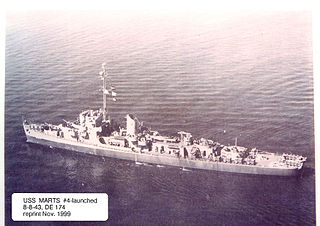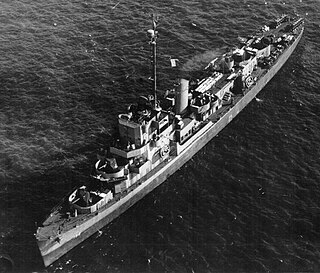
Destroyer escort (DE) was the United States Navy mid-20th-century classification for a 20-knot warship designed with the endurance necessary to escort mid-ocean convoys of merchant marine ships.

USS Cannon (DE-99) was a destroyer escort launched on 25 May 1943 by the Dravo Corporation in Wilmington, Delaware and was sponsored by Mrs. E. H. Cannon. Cannon was commissioned on 26 September 1943 and reported to the United States Atlantic Fleet. The ship was named in honor of George H. Cannon, a Medal of Honor recipient.

The third USS Davis (DD-395) was a Somers-class destroyer in the United States Navy. She was named for Charles Henry Davis.

USS O'Toole (DE-527) was an Evarts-class destroyer escort of the United States Navy during World War II. She served in the North Atlantic ocean protecting convoys and other ships from German U-boats and aircraft. She also performed escort and anti-submarine operations before returning home at the end of the conflict.

USS Alger (DE-101) was a Cannon-class destroyer escort built for the U.S. Navy during World War II. She served in the Battle of the Atlantic and provided escort service against submarine and air attack for Navy vessels and convoys. Alger was named for Philip Rounsevile Alger.

USS Marts (DE-174) was a Cannon-class destroyer escort built for the United States Navy. She served in the Atlantic Ocean in 1943-45 before being transferred to the Brazilian Navy. Renamed Bocaina (D-22), she was in service until 1975, when she was struck and scrapped.

USS Pennewill (DE-175) was a Cannon-class destroyer escort built for the United States Navy during World War II. She served in the Atlantic Ocean and provided escort service against submarine and air attack for Navy vessels and convoys.

USS Micka (DE-176) was a Cannon-class destroyer escort in service with the United States Navy from 1943 to 1946. She was sold for scrap in 1967.

USS Herzog (DE-178) was a Cannon-class destroyer escort in service with the United States Navy from 1943 to 1944. She was transferred to Brazil on 1 August 1944 and served as Beberibe (D-19) until 1966. She was scrapped in 1968.

USS McAnn (DE-179) is a retired Cannon-class destroyer escort built for the United States Navy during World War II. She served in the Atlantic Ocean and provided escort service against submarine and air attack for Navy vessels and convoys. She was transferred to the Brazilian Navy in 1944 and renamed as Bauru. She is now a museum ship preserved at the Brazilian Navy Cultural Center in Rio de Janeiro.

USS Gustafson (DE-182) was a Cannon-class destroyer escort in service with the United States Navy from 1943 to 1946. In 1950, she was transferred to the Royal Netherlands Navy where she served as Hr.Ms. Van Ewijck (F808) until 1967. She was scrapped in 1968.

USS Samuel S. Miles (DE-183) was a Cannon-class destroyer escort built for the United States Navy during World War II. She served in the Pacific Ocean and provided escort service against submarine and air attack for Navy vessels and convoys. She returned home at war's end with eight battle stars to her credit.

USS Eisner (DE-192) was a Cannon-class destroyer escort built for the United States Navy during World War II. She served in the Atlantic Ocean and the Pacific Ocean and provided escort service against submarine and air attack for Navy vessels and convoys. Eisner was named in honor of Jacques Rodney Eisner who was killed in action during the Battle of Guadalcanal on 13 November 1942 while serving in USS San Francisco. Following the war, the ship was transferred to the Royal Netherlands Navy under the Mutual Defense Assistance Program in 1951 and served as HNLMS De Zeeuw. The Netherlands returned the ship to the United States in 1967 and Eisner was sold for scrap in February 1968.
USS Knave (AM-256) was an Admirable-class minesweeper built for the United States Navy during World War II. She served in the Atlantic during World War II and was decommissioned in May 1946 and placed in reserve. While she remained in reserve, Knave was reclassified as MSF-256 in February 1955 but never reactivated. In October 1962, she was sold to the Mexican Navy and renamed ARM DM-13. In 1994, she was renamed ARM Cadete Juan Escutia (C56). She was stricken in 2000, but her ultimate fate is not reported in secondary sources.
USS Lance (AM-257) was an Admirable-class minesweeper built for the U.S. Navy during World War II. She was built to clear minefields in offshore waters, and served the Navy in the Atlantic Ocean.

USS Logic (AM-258) was an Admirable-class minesweeper built for the U.S. Navy during World War II. Built to clear minefields in offshore waters, she served the Navy in the Atlantic Ocean.
The second USS Magnet (AM-260) was an Admirable-class minesweeper built for the U.S. Navy during World War II. She was built to clear minefields in offshore waters, and served the Navy in the Atlantic Ocean.

USS Surprise (PG-63), the fourth American naval ship of the name, was a Temptress-class patrol gunboat during World War II. She was built as the British Flower-class corvette HMS Heliotrope, and was in service with the Royal Navy during the first years of the Battle of the Atlantic. She was loaned to and operated by the United States Navy from 1942 to 1945. After World War II, she was sold as a merchant vessel and ended her life in the Chinese navy as Lin I.
HMS Goodall (K479) was a British Captain-class frigate of the Royal Navy in commission during World War II. Originally constructed as the United States Navy Evarts-class destroyer escort USS Reybold (DE-275), she served in the Royal Navy from 1943 until her sinking in 1945.
ROKS Dangpo was a patrol craft of the Republic of Korea Navy (ROKN). Originally built as USS PCE-842, a PCE-842-class patrol craft for the United States Navy during World War II. Dangpo was acquired by South Korea on 13 December 1961 and sunk by North Korean coastal artillery fire on 19 January 1967.















